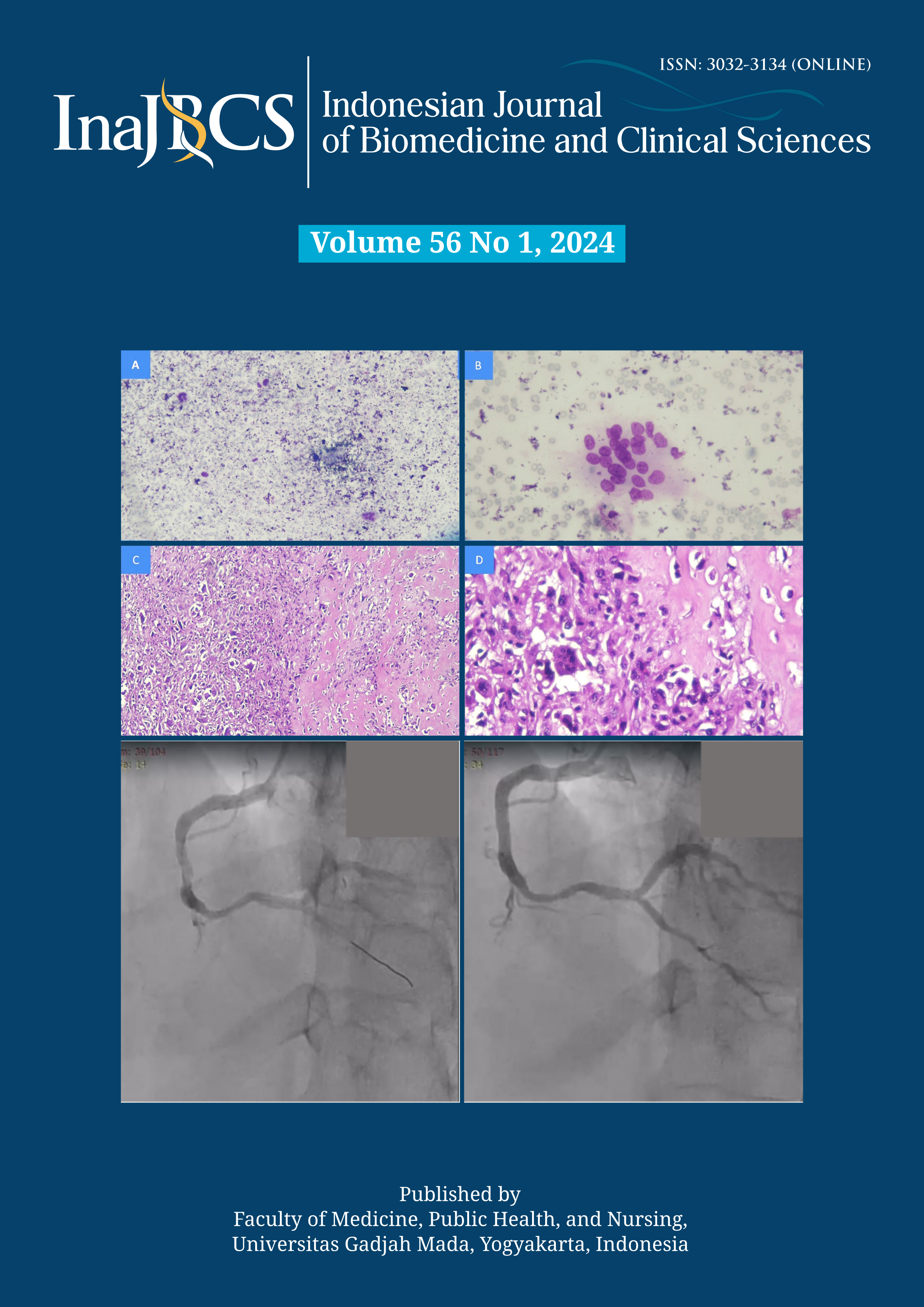Association between CDK4 expression and overall survival of osteosarcoma patients
Abstract
Osteosarcoma is the most common primary bone tumor malignancy, accounting for 30 - 80% of all primary bone tumors. It is presented in a bimodal distribution manner with the age of onset divided into two groups, 10-20 and >60 y.o. Various factors have significance in the patient's prognosis, including the expression of cyclin-dependent kinase 4 (CDK4). This CDK4 has an essential role in the pathogenesis of osteosarcoma through inactivation of the Rb gene, which is associated with the patient's survival. This study was conducted to evaluate the correlation between CDK4 expression and the survival of osteosarcoma patients. It was a cross-sectional study involving 50 patients diagnosed with osteosarcoma based on clinical, radiological, and histopathological examination. Available formalin-fixed paraffin-embedded (FFPE) samples were retrieved for immunohistochemical (IHC) staining of CDK4. The survival data was collected from medical records. CDK4 expression and survival data were analyzed statistically using the Kaplan-Meier curve. Out of 50 subjects, CDK4 was found to be expressed in 38 samples (76%). The group with negative CDK4 showed a slightly longer overall survival (by 0.2 mo) than the positive CDK4 group. However, these results were not statistically significant (p = 0.821). In conclusion, the overexpression of CDK4 may not directly affect the survival rate in osteosarcoma. Other factors need to be considered to understand the complexity of the disease.
References
Pizzo PA, & Poplack DG. Principles and practice of pediatric oncology 7th ed. Philadelphia:Wolters Kluwer Health;2015.
Misaghi A, Goldin A, Awad M, Kulidjian AA. Osteosarcoma: a comprehensive review. SICOT J 2018; 4:12.
https://doi.org/10.1051/sicotj/2017028
Komite Penanggulangan Kanker Nasional. Panduan penatalaksanaan osteosarkoma. Jakarta: Kementerian Kesehatan Republik Indonesia; 2015.
http://kanker.kemkes.go.id/guidelines/PPKOsteosarkoma.pdf.
Fletcher CDM, Bridge JA, Hogendoorn PCW, Mertens F. WHO classification of tumours of soft tissue and bone. Geneva: International Agency for Research on Cancer; 2013.
Taran SJ, Taran R, Malipatil NB. Pediatric osteosarcoma: an updated review. Indian J Med Paediatr Oncol 2017; 38(1):33-43.
https://doi.org/10.4103/0971-5851.203513
Hanahan D. Hallmarks of cancer: new dimensions. Cancer Discov 2022; 12(1):31-46.
https://doi.org/10.1158/2159-8290.CD-21-1059
Zhou Y, Shen JK, Yu Z, Hornicek FJ, Kan Q, Duan Z. Expression and therapeutic implications of cyclin-dependent kinase 4 (CDK4) in osteosarcoma. Biochim Biophys Acta Mol Basis Dis 2018; 1864(5 Pt A):1573-82.
https://doi.org/10.1016/j.bbadis.2018.02.004
Mitchell RN, Kumar V, Abbas AK, Aster JC. Robbins basic pathology, 10th ed. Philadelphia: Elsevier Health Sciences; 2017.
O'Leary B, Finn RS, Turner NC. Treating cancer with selective CDK4/6 inhibitors. Nature Rev Clin Oncol 2016; 13(7):417-30.
https://doi.org/10.1038/nrclinonc.2016.26
Hamilton E, Infante JR. Targeting CDK4/6 in patients with cancer. Cancer Treat Rev 2016;45:129-38.
https://doi.org/10.1016/j.ctrv.2016.03.002
Jiang Q, Mai C, Yang H, Wu Q, Hua S, Yan C, et al. Nuclear expression of CDK4 correlates with disease progression and poor prognosis in human nasopharyngeal carcinoma. Histopathology 2014; 64(5):722-30.
https://doi.org/10.1111/his.12319
Li W, Zhang S. Survival of patients with primary osteosarcoma and lung metastases. J BUON 2018; 23(5):1500-4.
Smeland S, Bielack SS, Whelan J, Bernstein M, Hogendoorn P, et al. Survival and prognosis with osteosarcoma: outcomes in more than 2000 patients in the EURAMOS-1 (European and American Osteosarcoma Study) cohort. Eur J Cancer 2019;109:36-50.
https://doi.org/10.1016/j.ejca.2018.11.027
Hung GY, Yen HJ, Yen CC, Wu PK, Chen CF, Chen PC, et al. Improvement in high-grade osteosarcoma survival: results from 202 patients treated at a single institution in Taiwan. Medicine (Baltimore) 2016;95(15):e3420
https://doi.org/10.1097/MD.0000000000003420
Mirabello L, Troisi RJ, Savage SA. Osteosarcoma incidence and survival rates from 1973 to 2004: data from the surveillance, epidemiology, and results program. Cancer 2009;115(7):1531-43.
https://doi.org/10.1002/cncr.24121
Faisham WI, Mat Saad AZ, Alsaigh LN, Nor Azman MZ, Kamarul Imran M, Biswal BM, et al. Prognostic factors and survival rate of osteosarcoma: a single-institution study. Asia Pacific J Clin Oncol 2017; 13(2):e104-e10.






